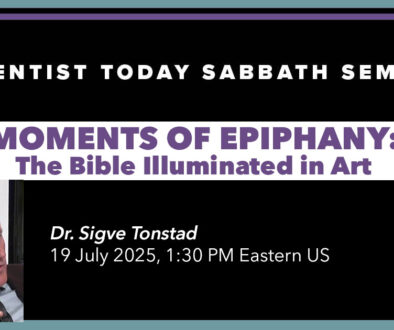Behind the “Son of Man”
Commentary on “Among the Lampstands,” Lesson for January 5-11.
by Werner E. Lange | 10 January 2019 |
John saw a special “son of man” among seven golden lampstands in the vision that introduces the seven epistles to the seven churches (Rev 1:12-20). The identification of this “son of man” can be easily made on the basis of parallel statements in the Revelation (see 2:18; 14:14; 19:11-13). But there is more behind his description.
In my article last week I mentioned that the most important principle for the right interpretation of the Revelation is determining the source of an allusion in Revelation to the Old Testament and the inclusion of its context in the interpretation (see PDF Revelation DIY 0, because it is fundamental).
In the description of the “son of man” there is an interesting allusion. The source is found in Daniel 10:5-6. You can find the verbal parallels highlighted in my elaboration on the introductory vision.
The identity of this person is not easy to discover in Daniel 10:5, but its context indicates that it was the “prince Michael” (or archangel, the prince over the angels; Dan 10:13, 21; cf. 12:1, 6-7). He was fighting with the “prince of the Persian kingdom,” apparently a demonic figure.
So, here we are dealing with a section of the great conflict between Christ and Satan. It is described in more detail in Rev 12:7-9, but with this description of the “son of man,” alluding to Dan 10, we have a first reference to this conflict and thus to the fundamental theme of the Revelation. And you will find hints to that conflict in nearly all chapters of the first half of Revelation. Watch out for it.
Daniel 10:5 describes Michael in “linen clothes,” but the son of man wears “a long robe (Rev 1:13 ESV).” This difference in the choice of words is significant because the text uses a special word that only occurs here in the NT (podērēs). In the Greek translation of the Old Testament (Septuagint) of Ex 28:4 and Zech 3:4, in the Apocrypha (Wisdom 18:24; Sirach 45:8), and especially in the Jewish literature from the time of John, it designated the robe of the high priest. This term is also used in the Septuagint version of Dan 10:5. For Jewish Christians it was thus clear that the son of man is here portrayed in his high priestly role.
Another interesting feature of the description of the “son of man” that is often overlooked is the fact that it has even greater parallels than to Daniel 10 to the Apocalypse of Zephaniah, a Jewish apocryphal scripture from the first century. Its basic theme is the divine final judgment, which God will carry out through angels. There we find the description of an angel named Eremiel, which is very similar to the description of Christ in Rev 1:12-20. You can read about it in the mentioned PDF.
Read the entire commentary here.
P.S.: The video about hints to Revelation’s interpretation in its introduction which I mentioned last week is now available on YouTube, too.
Werner E. Lange is the retired book editor of the German Adventist Publishing House




